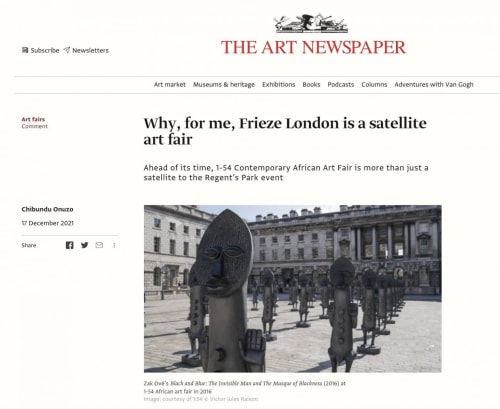Aerial Basket Ball paintings
1:54 Contemporary African Art Fair
The courtyard of Somerset House. Strand, London WC2R 1LA
14 – 17 October 2021
Every year, I wait for October to come round. The air is crisp, the leaves turn red and the highlight of the London art season takes place: 1-54 Contemporary African Art Fair.
Named after the 54 countries on the continent, 1-54 was founded by Touria El Glaoui. Its maiden edition was held in London in 2013 and, since then, the fair has travelled to New York and Marrakech.
For months, I count down to the centre of my art-world galaxy. What galleries will be coming to the fair? Which artists will be showing? Will I discover the next Bisa Butler or Ndidi Emefiele, stars who have shown at 1-54 early in their careers?
Apparently, there’s another art fair that happens in London at a similar time: Frieze, or something like that. I’ve never been to Frieze. I’ve always meant to go but then I get swept up in the talks and events that happen at and around 1-54. “Next year,” I say to myself. “Next year, I’ll finally make it down to Regent’s Park.”
Thus, I was distinctly surprised when I heard a seasoned art collector describe 1-54 as a ‘satellite fair.’
“Satellite of what?” I asked.
“Frieze, of course.”
Once he said it, I saw his point. 1-54 is always held in October, probably to take advantage of the international collectors who fly down to London for Frieze. Seen from this angle, 1-54 is a satellite fair of Frieze. But what if you’re not a mega collector but someone like me, whose love for African art led them to 1-54? Or what if you are a mega-collector but your primary area of focus is art produced by African artists and artists of the African diaspora? Then I would argue that 1-54 would be your main event and Frieze would start to look like the satellite.
Historically, longer running fairs like Frieze, Art Basel and the Armory Show have not given much floor space to Black and African artists. Things may have slowly started changing but 1-54 was celebrating contemporary African art before it was trendy to. As someone who keenly follows new developments in contemporary African art, there was only one place for me to be this October.
Diverse and singular
This year’s fair did not disappoint. In the space of two hours, I saw art from Ghana, Nigeria, Cameroon, South Africa, Kenya, Morocco and the list went on. The styles and the mediums were different. There was photography. There was oil painting. There were NFTs. There were installations. The more I saw, the more I concluded that the only thing the works had in common was that the artists had some link to Africa. Apart from that, the work produced were diverse and singular.
The work of three artists stood out for me. One was the writer, artist and curator Everlyn Nicodemus. Although she has had a long career and been exhibited from Australia to her home country of Tanzania, she is a discovery for me. Her work is vivid but pensive. In The Omnipresent One (1986), a Madonna-like figure looms across the canvas, brightly clothed but bent in some unknown grief or sorrow.
Reclaiming the black portrait
In contrast were the dreamy works of Sahara Longe, an artist at the start of her career. She reclaims the portrait of the black figure. In Edwina (2020), a woman stands with her eyes c/onfronting the viewer, her background a shifting, flickering grey-blue. Her dress is made from a patterned fabric that seems a more muted version of Adele Bloch Bauer’s, in Klimt’s famous painting.
And, last, were the embroidered photographs of Joana Choumali. Innovation in a medium as established as photography is rare but somehow Choumali manages to do this. Her photographs are of pedestrian scenes in West Africa: women walking in the market or children playing in the street. But the images are often captured in the glowing light of dawn and then Choumali overlays these images with sparkling, embroidered threads. The effect is simply magical. The juxtaposition of the everyday with the fairy morning light stops the work from crossing over into twee.
In conclusion, I didn’t make it to Frieze this year. But next year, I promise I’ll try harder. Even though contemporary African art is my first love, it is important to cross pollinate and broaden my own horizons. We are all enriched by exchanges beyond our comfort zone. So, reader, I’ll make a deal with you. If Frieze London is the centre of your art world, then next year, why don’t you pay a visit to the satellite fair of 1:54 and I’ll pay a visit to the satellite fair of Frieze?
Chibundu Onuzo is a novelist and fellow of the Royal Society of Literature
17 December 2021


